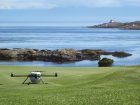
Features
Autonomous Equipment & Battery Power
Golf
Tapping into turf technology
December 7, 2016 By David McPherson
 Mark Prieur, superintendent at Trafalgar Golf and Country Club, is a firm believer in the technology that drones present
Mark Prieur, superintendent at Trafalgar Golf and Country Club, is a firm believer in the technology that drones present The old adage “a picture is worth a thousand words” is a refrain to which golf course superintendents subscribe. Photographs help turfgrass managers explain agronomic and maintenance programs to members and sell renovation and capital improvement projects to boards of directors; a smartphone snapshot is now a powerful and ubiquitous communication tool of the trade.
Imagine the thrill then when the ante is upped in the visual communication game from hand-held pictures taken with one’s phone to detailed visuals taken by drones 200 feet high in the sky that can provide a wealth of useful data.
Drones, once viewed by many as simply a recreational toy and a way to take bird’s eye view pictures of one’s course—mainly for marketing purposes to share on YouTube, other social media, or one’s website—are now a useful agronomic aid and money-saving technology that provides everything from a clearer picture of where the divots occur most frequently on your course to areas that are suffering from a lack of irrigation.
Mark Prieur, golf course superintendent at Trafalgar Golf and Country Club in Milton, Ont., just west of Toronto, bought a drone last year. Every day, he finds new uses for this technology: from taking aerial shots that show frost on the course and tweeting them so members know why there was a delay in tee times to helping him train his employees by showing proper techniques from a new, unique angle.
“It’s just another tool,” Prieur says. “When you get it, you start using it for things you never thought you would use it for. I recently used it for training purposes to show my staff a bunker taken with the drone and explaining that this is what a properly raked bunker is expected to look like when it’s done.”
Others, like Prieur’s colleague to the north—Paul Scenna at Beacon Hall Golf Club in Aurora, Ont.—still are a little slower to adapt to, and embrace, these new
technologies—although they do see their overall value to making one’s job easier.
“To be honest, I’m the wrong guy to talk to about this topic,” says the seasoned superintendent. “I don’t use a lot of technology. I’m still a believer that you’ve got to be on the course and look at things first-hand. That said we do use some technology. We can run our irrigation system from our phones, which offers great control and is really handy.”
Looking ahead, the data drones and other technologies can now provide to superintendents—like Prieur and Scenna are discovering—is limitless thanks to innovative companies like GreenSight. GreenSight’s drone-enabled golf course service provides superintendents valuable information to help them manage their staff more effectively, reduce water usage, optimize fertilizer use, and avoid costly pest or fungal damage while maximizing the quality and playability of one’s course.
“We started in 2015 with one-time surveys for golf courses, giving them a map of their course much better than what you would get from Google,” explains Justin McClellan, chief marketing officer, GreenSight Agronomics. “That was our beginnings. We quickly realized there was a need, and an interest, for this high-resolution imagery of the turf.”
GreenSight’s principals’ backgrounds are all in military drone systems using custom sensors. They figured they could use their expertise in drone technology to put together an interesting thermal camera sensor package that could read and measure the moisture levels in the grass over the whole course.
“We also realized we could use a multi-spectral camera to start looking for turfgrass diseases and pests,” McClellan adds.
Endless usages for technology
The uses for this new technology are endless: from being able to show shade patterns on fairways at any given point in time to seeing and identifying other troublesome patterns on the course before they become issues. The automated drone technology GreenSight developed scans every inch of one’s course multiple times a week. Its custom multispectral camera captures five times the data of a typical camera and enables them to detect evidence of pests and pathogens before they become visible to the naked eye. GreenSight’s thermal cameras also measure the precise temperature of all of the course’s turfgrass. After these scans are complete the drone lands on its base station and is automatically recharged while the image data is downloaded. The extensive data is then processed by GreenSight’s proprietary analysis software. The company scans the multispectral image data for evidence of pests or pathogens and tracks daily changes so they can alert the superintendent when an issue begins, long before it gets out of hand. The temperature data is analyzed and used to develop a soil moisture map of the course. Areas that are too dry or too wet are flagged, before the grass health begins to deteriorate.
After each flight survey, GreenSight’s system automatically sends the user an email or text message report based on the scans to let courses know what issues are happening and where. You can also easily compare today’s imagery to last week’s, last month’s, or last year’s with its easy to use app or website.
“We offer a complete system: our camera/drone and the assembly and installation of the drone that is off-the-shelf technology, but built around our camera,” McClellan explains. “We include software that puts all the images together. With daily flights, we can see what changed from yesterday to today. Instead of just 100 acres of photos, our software can analyze for you detailed data like here are the 20 acres on the course where we saw something change: the 10 places we saw the course drier and the 10 places we saw the beginnings of a pest infection. We hope to save superintendents time, not give them too much data that they don’t know what to do with.”
This fall, Greensights started rolling out this technology to courses in Florida and Arizona zones with a subscription-based service and App that measures soil moisture technology via thermal images that will tell golf course managers the percentage of moisture in their soil.
“For example, that could be a very powerful tool for someone looking at installing a new irrigation system where they have independently controlled sprinkler heads,” McClellan says. “Superintendents will be able to see on a daily basis areas that are drying out or receiving too much water and can easily pinpoint issues with the irrigation system like leaks.”
How companies such as GreenSights integrate and share the data once it’s collected is the key to the technology reaching its full potential. With all that data being collected there is a need for sophisticated reporting and analysis. A superintendent won’t get the full benefit of this tool without data interpretation and integration between systems like golf carts, labour tracking, and GPS sprayers. Without this cooperation, golf course managers risk having an overwhelming amount of data that will never be useful.
Print this page

